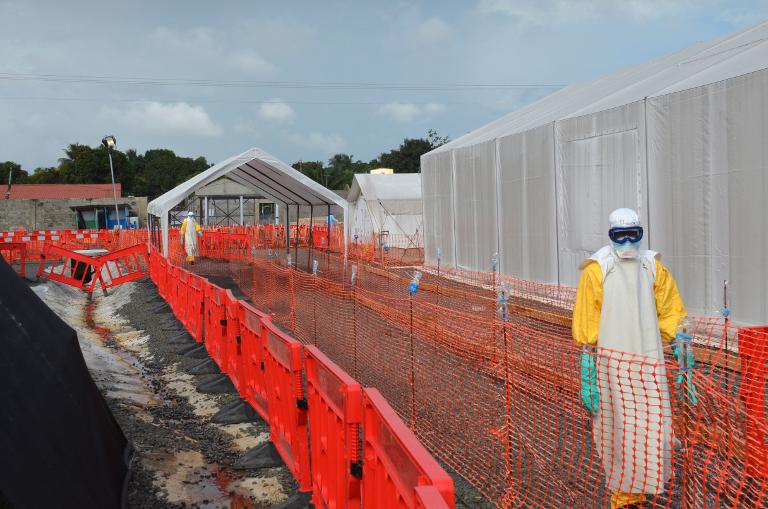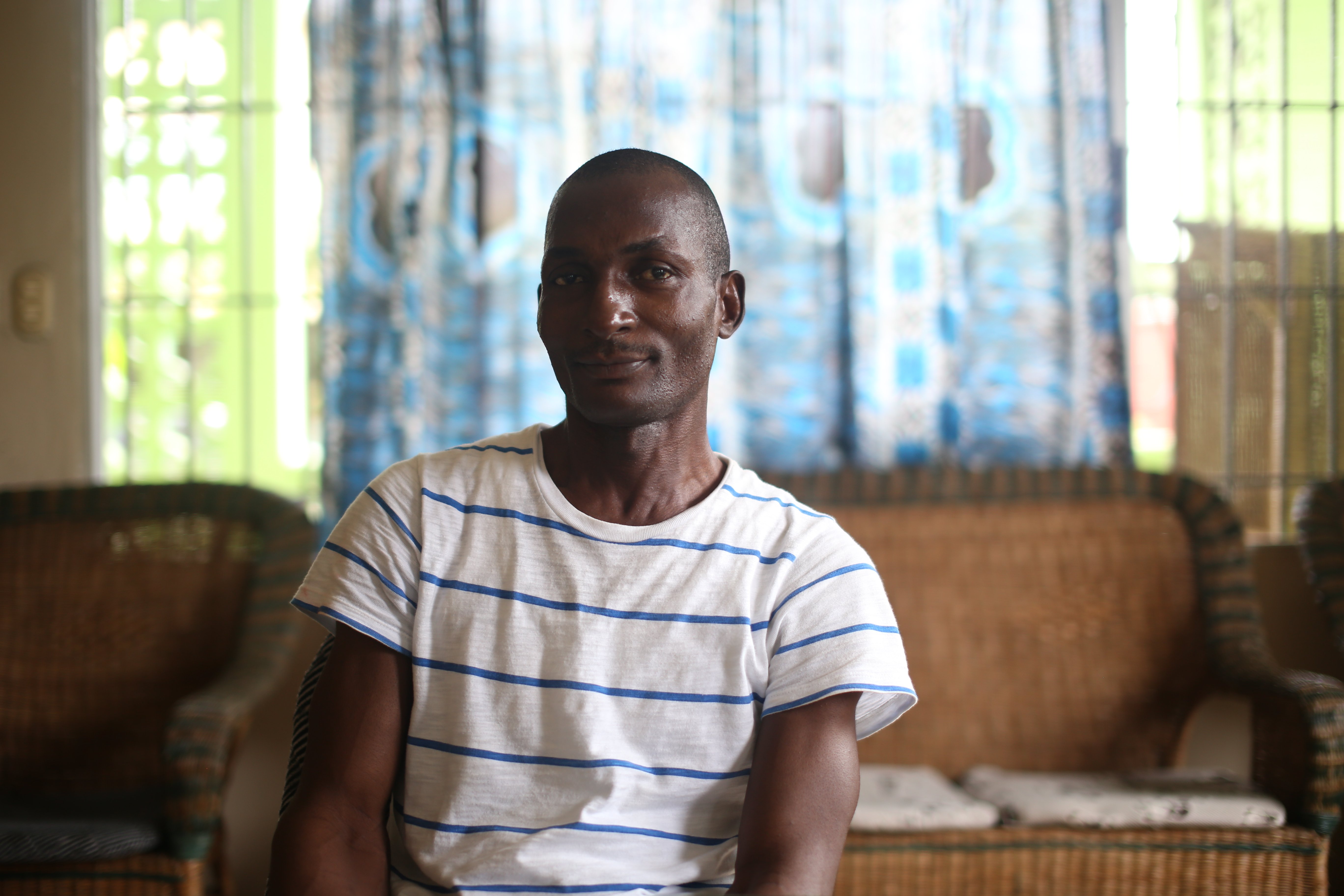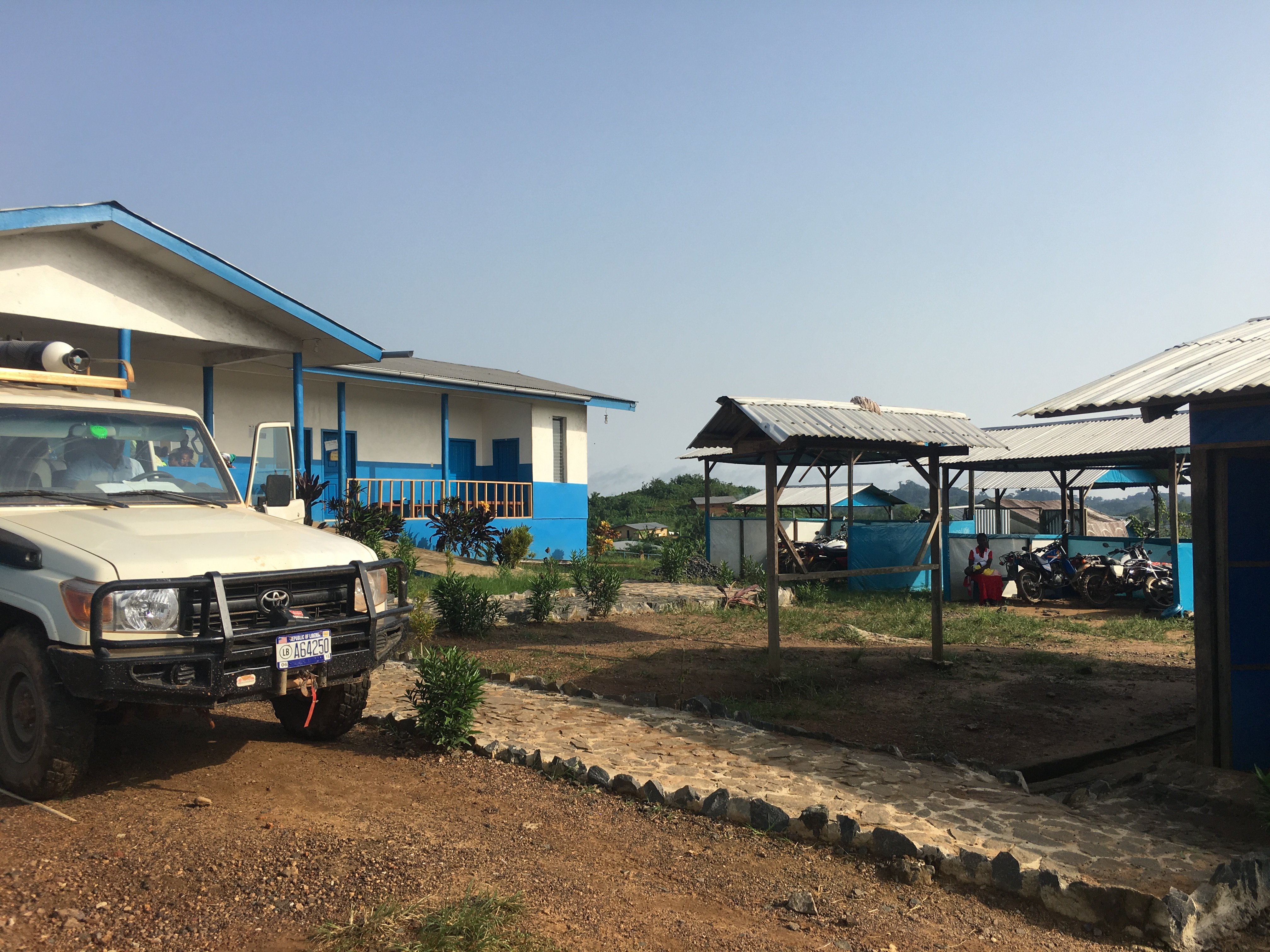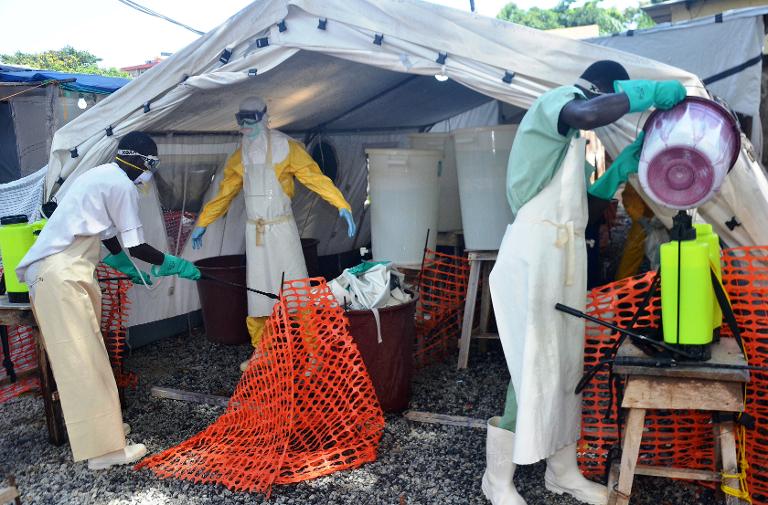Ebola has flared up again in the Democratic Republic of Congo
Musu lies on her side in a cot in the Tubmanburg public hospital in Liberia’s northwestern Bomi County. She grips the creamcoloured bed rails, waiting for her father to clean her fresh surgical wounds.
The 11-year-old is recovering from an operation to fix severe burn scars on her face and neck, the excruciating injuries left over from a fall into a fire four years earlier.
The scars were not properly treated while she healed, so the skin on the left side of her face and neck has thickened and tightened, creating what doctors call “burn contractures”.
She could not move her head, blink her left eye or properly close her mouth.
“That’s an extremely difficult case,” says Kevin Strathy, the plastic surgeon from Florida, in the United States, who performed the surgery.
At the time, he was the only plastic surgeon in the country.
Four years later, even basic medicines are in short supply
Musu endured her debilitating injuries for four years because serious burn contractures can only be fixed with plastic surgery, and Liberia has no plastic surgeons.
She and her family thought she would live with her injuries forever. That was until Strathy and his wife Natu, a surgical nurse, arrived in Tubmanburg to perform free plastic surgeries on Liberians in need.
Despite efforts by the Liberian government and the international community to rebuild and strengthen the country’s healthcare system after the Ebola epidemic of 2014 and 2015, many of the systemic issues that got in the way of responding to the Ebola crisis remain. The virus spreads by direct contact with infected bodily fluids. Nursing sick loved ones, traditional burial ceremonies and even handshakes became potentially deadly acts.
Within a few months, thousands were infected. Four years after the start of the outbreak, prohibitively high costs for treatment and access to medicine get in the way of preventing, diagnosing and treating even basic ailments.
“If you talk to someone who is using the health facility, if she says it’s much worse, I would not really argue with her,” says Alex Gasasira, the World Health Organisation (WHO) representative in Liberia. “The system is complex and there are still many, many weak points.”

Liberia’s civil war shackled the development of its health system, in some ways setting the stage for the 2014 Ebola epidemic.
When the Ebola epidemic hit Liberia in 2014, its healthcare system, already frail from years of civil war, collapsed. Hospitals and clinics were overrun to the point that even women in labour were turned away. The government struggled to co-ordinate the distribution of basic medicine and protective gear. As the virus spread, international funding and aid workers flooded into the country in an attempt to stop what many thought might become a global pandemic.
More than 5000 people died before Liberia was declared Ebola-free, a number that includes nearly 10% of the healthcare workforce, according to 2015 estimates published in The Lancet medical journal.
It was the highest fatality among health workers rate in the three countries — Guinea, Liberia and Sierra Leone — most affected by the epidemic.
The viral catastrophe that was Ebola has now been replaced by a much less talked about silent healthcare crisis.
It is difficult to measure whether or not the system is worse off now than it was before the epidemic because the data is still being gathered. The next Demographic and Health Survey is only expected later this year and the most recent one is from 2013, pre-Ebola. The ministry of health conducts an annual review each year, which provides some insight into the system.
In 2016 less than half the country’s government health facilities had medication in stock for common illnesses, the review states. Only 57% had the basic equipment necessary to provide health services and nearly half had no electricity.
But the annual report, along with other data gathered by the ministry of health, says Gasasira, is prone to underreporting. It relies heavily on data gathered in health facilities and misses what happens out in the communities.

The month Vandross Payne spent in recovering in the public sector John F Kennedy Hospital left him almost R 2000 in debt. (Clarissa Sosin)
Vandross Payne, an unemployed graphic designer, sits on a tan and green wicker chair in a living room in Sinkor, a neighbourhood in the capital, Monrovia.
Just a week earlier Payne (41) was released from Liberia’s biggest public hospital, John F Kennedy Medical Center — or, “Just For Killing” as it is not-so-affectionately called here. He’d gone to the hospital to get help for rectal bleeding, he says — the result of untreated haemorrhoids. During his month-long stay he received multiple blood transfusions. When the bleeding didn’t stop, the doctors decided to operate.
Payne suffers from a host of chronic medical problems that require regular treatment: glaucoma, a build-up of pressure in the eye that can lead to vision loss and blindness; hepatitis C which can cause liver damage and lead to cirrhosis, liver cancer, or liver failure; and the haemorrhoids. But he only seeks medical care when absolutely necessary, he says, because he can’t afford it. The rest of the time he self-treats with medication from the pharmacy. But even that is sometimes too expensive.
“Every time you feel sick you worry about money,” Payne says. “If you don’t have money then that’s it.” On paper, healthcare is free for Liberians. But in reality it is far from it: costs vary depending on where you live and what type of facility you go to.
According to the US-based research organisation Institute for Health Metrics and Evaluation, Liberians spent $27 (R354) per person on out-of-pocket healthcare expenses in 2015.
The month Payne spent recovering in John F Kennedy Hospital left him weak. His cheeks are hollow and his cheekbones protruding. It also left him $120 (R1 570) in debt. He hasn’t had the strength to work so paying the money he owes has been difficult. The last time he went to the hospital he did not receive treatment, Payne says, but was asked to pay off part of the debt before being sent away. He still owes the hospital $75 (R980).
All that is left for Payne, he says, is to ask around for money.
“I am still young and don’t want to die yet.”

JJ Dossen Hospital in Harper is better off than most in the country because the facility still has a relationship with the international organisation Partners in Health. (Diana Culbertson)
A girl in a white dress that looked like it was once part of a princess costume was waiting with her mother when Diana Culbertson did her early morning rounds in August 2017 in the pediatric ward at JJ Dossen Hospital in the southeastern city of Harper.
The mother had brought her daughter — she looked to be around six-years-old — to the hospital because she was vomiting. The girl tested positive for malaria and was put on medication.
According to the Institute for Health Metrics and Evaluation, malaria was the second leading cause of death in Liberia in 2016.
The girl seemed to be recovering quickly. She’d stopped vomiting and was smiling, but Culbertson was worried. She thought the girl looked puffy, a sign that the malaria might have damaged her kidneys. Instead of discharging her, she ordered an iStat, a simple, hand-held blood test. If the protein levels in the blood were too high, the young girl had kidney damage and would need to stay for more treatment.
Culbertson was an American physician’s assistant with Partners in Health Liberia, one of the international organisations that responded to the Ebola epidemic and remained in the country afterwards to rebuild the healthcare system. Partners in Health oversees the hospital. Because of this relationship, JJ Dossen is in better shape and has more resources than other healthcare facilities.
This was Culbertson’s second time working in Liberia. Her first placement was at the end of the Ebola epidemic as a physician’s assistant with the American Refugee Committee. She worked at their Ebola treatment unit in River Gee County, where they never saw a single case of the virus. The building that was constructed for the unit now sits unused, says Wynfred Russell, the former Ebola emergency response manager for the American Refugee Committee. It is overgrown with weeds and has been looted.
It was during Culbertson’s time in River Gee that she witnessed the flaws in the Liberian healthcare system. As the epidemic ended, she’d been hopeful that the crisis would bring about change. She thought it was an opportunity for Liberia to strengthen its healthcare system and address the issues that exacerbated the crisis in the first place. Culbertson was even in talks with the American Refugee Committee to stay on after the crisis and work on health care development in River Gee.
But then reality hit. The American Refugee Committee wasn’t able to find funding to stay in the country. Culbertson and the rest of the team were sent home. Although some organisations, such as Partners in Health, received donor grants to stay, most either couldn’t or didn’t try. The aid organisations that responded to Ebola steadily made their way out of the country.
“The disaster relief part of it is sexy but then the rebuilding part somehow isn’t,” says Culbertson.
When she returned in 2017 with Partners in Health, she was disheartened to see how little progress had been made. Even though the hospital she worked in was relatively well resourced, she still saw many of the same issues she’d seen years earlier, such as the lack of resources and medication.
According to the ministry’s annual report, less than half the country’s health facilities had the resources to run diagnostic tests in 2016.
Without a precise diagnosis it can be difficult to prescribe treatment. More often than not, Culbertson says, they will give the patient broad-spectrum antibiotics and hope for the best.
Near the end of her rounds Culbertson received the young girl’s test results. As she suspected, the girl’s protein levels were high. Malaria had damaged her kidneys. Culbertson told a nurse to let the family know they’d need to spend another night at the hospital.
“If you can’t take care of those very basic things,” she asks, clearly frustrated, “How do you expect to take care and have surveillance for Ebola and more advanced things?”
The few and the proud: Liberia boasts less than 300 doctors
For Rick Sacra, a doctor at the private missionary-run Elwa Hospital just outside Monrovia, healthcare development in Liberia is a long game. He’s worked in and around the country since 1987 and knows what healthcare was like before, during and after the civil war, which started in 1989 and went on almost continually until 2003, pre-Ebola and post-Ebola. He remembers when there were at most 40 doctors, a mix of foreign and Liberian, doing clinical work in the entire country.
“Compared to that, we’re living in the lap of luxury now. We’ve got so many doctors!” he says in an interview in a café in his second home of Holden, a small town in Massachusetts in the US.
In 2016, there were 234 doctors in Liberia, according to the ministry’s annual report.
Unlike Culbertson, Sacra did not have high hopes that the healthcare system would get better after Ebola.
“It’s a totally different set of priorities and mind-set. In fact, it’s the opposite,” says Sacra, explaining the difference between emergency response and healthcare development. “The way the world’s funding system works is to respond to the next crisis, right? So once Ebola wasn’t a crisis anymore people lose — donors lose — interest.”
Sacra won’t deny that the epidemic laid bare the flaws in Liberia’s health care system. He worked at Elwa’s Ebola treatment unit, where he eventually contracted the virus. Sacra witnessed the system’s collapse firsthand.
He remembers the fear that patients developed during the epidemic of going to healthcare facilities. Hospitals and clinics became places people went to get sick, not to get healthy. This mentality carried over after the epidemic ended, causing people not to seek treatment when they needed it. After the epidemic, Sacra saw people with illnesses such as high blood pressure and advanced HIV. Before the epidemic they would have sought treatment sooner, he says.
But progress comes slowly. To do it successfully and sustainably, organisations need to be fully integrated with the training programmes and hospitals, Sacra explains.
“You have to have a long view. You’re not going to get a strengthened health system in a year. It’s a generational intervention.”

Ebola wiped out nearly 10% of Liberia’s doctors and nurses.
The disease surveillance team gathers in a room on the first floor of the National Public Health Institute of Liberia, a hastily constructed building across the street from the health ministry. Remnants of construction lie on the ground outside next to parked white pickup trucks with “Ebola Response” emblazoned across their sides.
The team is touted by many as one of the great successes of post-Ebola strengthening efforts. It is a joint effort between the health ministry and the WHO. Each week they post reports online that document cases of contagious diseases such as measles, meningitis and yellow fever as well as other important health issues such as maternal and neonatal mortality. By the end of May, they’d published more than 60 bulletins.
In 2017, for example, they caught a meningitis outbreak in the country’s southeastern Sinoe County. It is a great success, but the surveillance team is not perfect, says Gasasira. During spot checks they’ve caught team members not actually going out into the field, he says, but rather falsifying their numbers. Like the ministry’s annual report, the data is based on what happens in healthcare facilities. It misses what happens out in the communities. The data is about 70%-80% accurate, Gasasira estimates.
For Tolbert Nyenswah, the director of the National Public Health Institute of Liberia, the surveillance team is just one part of the puzzle. Since its launch in 2016, the institute’s priority has been the surveillance team. But much more needs to be done, including the continuation of the implementation of a healthcare investment plan published in 2015 near the end of the Ebola crisis as well as the promotion of the administration’s pro-poor development agenda, which gives top priority to health and sanitation.
“One disease collapsed our healthcare system,” he says. “Progress has been made but we need to do more.”